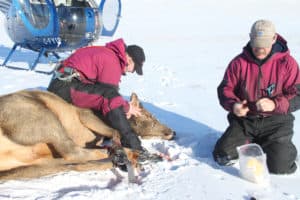Share this article
Study documents wolves’ role transforming Yellowstone
When gray wolves (Canis lupus) were reintroduced in Yellowstone National Park in 1995, nobody could have predicted the sweeping changes they would help bring to the ecosystem, from reducing elk numbers (Cervus elaphus) to increasing bison numbers (Bison bison) to restoring willows, cottonwoods and aspens.
Their return to the landscape after a 69-year absence initially triggered “a behavioral trophic cascade,” said TWS member Mark Boyce, professor in the department of biological sciences and Alberta Conservation Association Chair in Fisheries and Wildlife at the University of Alberta, who has devoted much of his career to studying the Greater Yellowstone Ecosystem.
“The wolves just took off,” he said. After two releases over two years, wolf numbers continued to climb, peaking and then falling off to an equilibrium of about 100 wolves inside the park. “The population in the park hasn’t changed hardly at all in the last 10 years,” he said.
In places where the wolves concentrated, the elk became scarce, Boyce said, allowing willows to return to places where the elk had eliminated them. With the willows came a variety of species, from beavers (Castor canadensis) to yellow warblers (Dendroica petéchia), that relied on riparian vegetation. “It was all in the packet,” Boyce said.
His latest study on wolves in Yellowstone, published in the Journal of Mammalogy, is a synthesis of 40 years of research that he and his graduate students have conducted in the park. It’s a “last hurrah,” he said. “We’ll let former graduate students take over now. Forty years is enough.”
Boyce’s paper looks at how Yellowstone’s experiment in allowing the ecosystem to manage itself with minimal human intervention resulted in a complex, heterogeneous system that varies from valley to valley, depending on topography, vegetation, soils and hydrology.
The system has seen bears — both grizzlies (Ursus arctos) and black bears (U. americanus) — play a greater role influencing elk calf survival and bison replacing elk as the dominant herbivore on Yellowstone’s Northern Range.
Some of the changes Boyce did predict.
“In 1988, I developed a computer simulation model to anticipate what would happen if wolves were reintroduced — the effect on the elk, bison, moose and deer.” Boyce said. He copied the model onto five-and-a-quarter-inch floppy disks and sent them off to high schools and government offices.
The predictions were right on target for the first decade, Boyce said. “It was unbelievable how well a predator-prey model was able to predict what was going to happen.”
Yellowstone’s ecosystem had been dominated by elk, which were “clobbering” the park’s vegetation, he said. When the wolves arrived, it became largely a two-species system, he said, and Boyce’s model did a good job of plotting the effects.
“But then, after about 10 years, life started to get complicated,” he said.
Bear predation on elk calves started to grow. Cougars (Puma concolor) returned to the landscape. Bison numbers increased. All three species became “big players on the system,” he said, resulting in a far more complicated system than his early model could have predicted.
But while wolves have transformed the Yellowstone ecosystem, Boyce said, the same cannot be said outside the park, where humans remain the dominant force on the landscape despite the wolf’s growing numbersgrowing wolf numbers. Hunting affects the ungulate prey for wolves, he said, and livestock offers easy prey, so that even in national forests, wolves can’t play the same role they played in Yellowstone, where hunting and livestock are forbidden.
“It’s the humans that are driving the system from the bottom,” he said.
Future researchers will have to see what further role the wolves play, Boyce said. As bison numbers climb, will wolves be able to control them? Bison are difficult prey for wolves, he said, but they’ve succeeded in specializing on them in other areas.
“That’s the big unknown right now,” he said.
Header Image: A member of the Wapiti Lake pack is silhouetted by a hot spring in Yellowstone National Park, where the reintroduction of wolves has reshaped the park’s ecosystem. ©Jacob W. Frank/NPS









